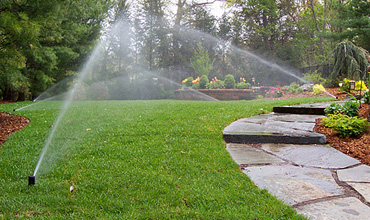Sprinkler Install Tulsa A home’s curb appeal is quickly becoming a main focal point in any residence and a terrific way to maintain that “wow” factor outside the home is to install your own sprinkler system.
Watering your lawn by hand can be a tedious job that takes too much time, especially in the summer. Sprinkler systems are a convenient way to water your lawn even if you’re not home. Additionally, an efficient sprinkler system uses less water than watering with a hose. Over the years, this can amount to huge savings on water bills.
Installing a sprinkler system is a fairly involved job that can take multiple days to complete. However, with the right guidance and proper tools, you can save hundreds of dollars by installing a sprinkler system yourself. See how with our step-by-guide below. Sprinkler Install Tulsa
Sprinklers
Sprinkler Installation Costs Sprinkler Install Tulsa
To start off, according to our sprinkler system installation cost guide, the average cost of the project is $2,310. Of course, the price will largely depend on the size of your lawn, as well as the equipment chosen. Bear in mind that the installation requires trenches for the pipes and will therefore tear up your existing lawn. Regardless of whether you choose to do it yourself or have professional installation, the lawn will need repairing, which adds to the total cost.
Steps Before Sprinkler InstallationHunter
Since you are performing work outside the home, you should check with your local building department to obtain necessary permits. Then, call your utility company to mark the buried cables and lines in your yard. This service is not too expensive, but a necessary step in any sprinkler system installation.
Check your water pressure. If it’s strong, then you may not have to install as many sprinkler heads. If it’s weak, then your costs could rise. Afterwards, turn off the water supply from the house. Check Hunter for guides and parts.
Note: Sprinkler systems are installed in zones, but estimating the cost is not as simple as multiplying the size of one zone by your total zones. Zones consist of five to 10 sprinkler heads. As our friends at the DIY Network points out, it’s important to have the spray from one sprinkler head make contact with the other heads to ensure that there will be no dry spots in the yard.
Connect Water Line
Hopefully, your foundation has an existing spigot to provide water for irrigation. Many homeowners choose this route, whereas most contracting professionals tap main water-service lines. Homeowners must install an anti-siphon valve to prevent lawn chemicals or fertilizers from entering the water supply.
Dig Trenches
Time to get dirty. Thanks to your local utility company, you know exactly where your water lines run. You must rent a trenching device from a local hardware or landscaping store. Many stores will deliver this heavy device for a fee.
Dig trenches along the lines six to eight inches deep. When you’re digging, do not throw the dirt or sod into one big pile. Keep both the sod and soil on opposite sides of the trenches. This will make the patching much easier. Sprinkler Install Tulsa
Valve Manifold
Install the Sprinkler Centerpiece
We need a device that connects all pieces of our sprinkler system and transmits messages from one end to the other. This piece is called the valve manifold (pictured above). Dig a hole so you can comfortably place the box inside the ground. Then, attach the valve to the main water line. Tighten and make sure nothing is loose.
Fill in the soil and then line the rest of the hole with two inches of gravel. The box lid should be flush with the grass.
Note: The other end of the valve should still be open.
Connect the Pipes. Check Hunter for guides and parts.
Lay PVC pipe (3/4″ to 1”) in all the trenches leading from the valve box. You may have to cut into the main water line and splice in a tee fitting with PVC cement and primer. You can use 90-degree elbows to join the PVC water pipes in the trenches to the zone valve pipes connected to the valve box. Use “tee” connectors for pipes running off the main line.
Connect the PVC pipe to the open end of the valve manifold. You may need a little adhesive to connect all pipes. Sprinkler Install Tulsa
Install the Sprinkler Heads
Hopefully, you have already picked out the best sprinkler heads for your yard and budget. Before installation, run the water through the system to give it a nice cleaning.
Connect the sprinkler heads as indicated on their instructions. You may have to push part of the fitting into the pipe. Place the sprinkler heads on the risers and make sure they are level with the ground. Once they are connected, fill in the holes with soil and sod.
Finish It Off
Most sprinkler systems have control panels you can mount on a wall. The instructions should show you how to connect the wires to make sure everything runs smoothly. Then, connect the system to the main water line. Turn on the system and see if it works.
If it does, congratulations.
If not, go back and make sure all pipes are securely connected and no water is leaking. Also, be sure to adjust your sprinkler heads to make sure you’re not wasting any water on your driveway or sidewalk.
Conclusion. Check Hunter for guides and parts.
Sprinkler systems may seem like an unnecessary expense, but when evaluated in the long run, they are cost effective and can save you hours of lawn maintenance. It will save a considerable amount of water, but more importantly, keep your grass looking as green and luscious as the first day you moved in. Sprinkler Install Tulsa

